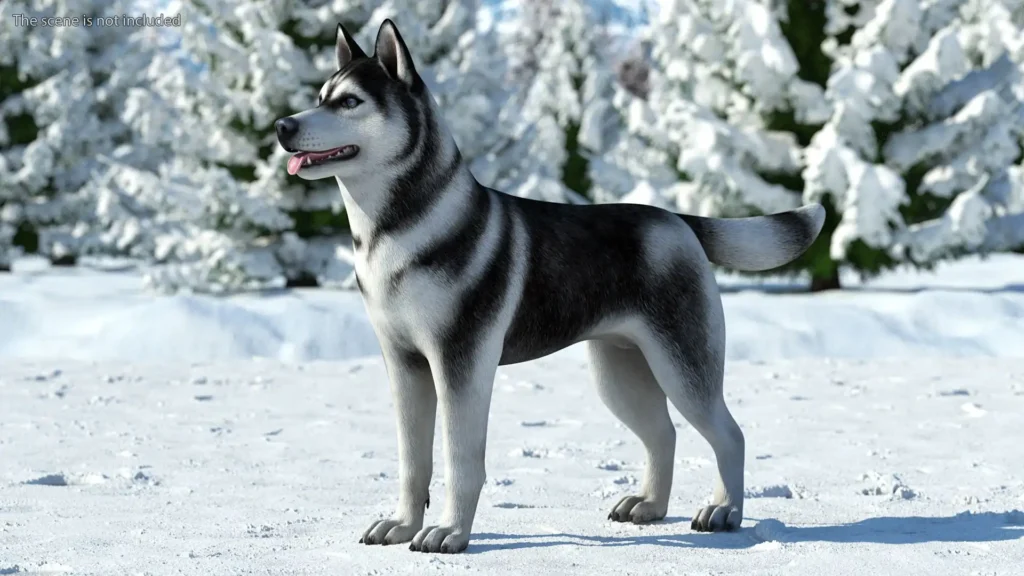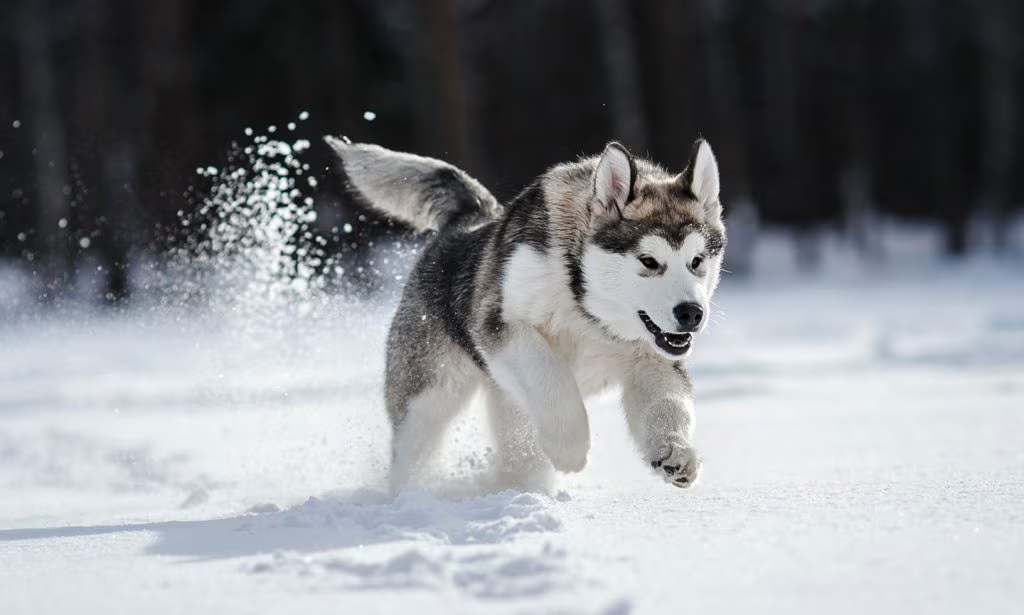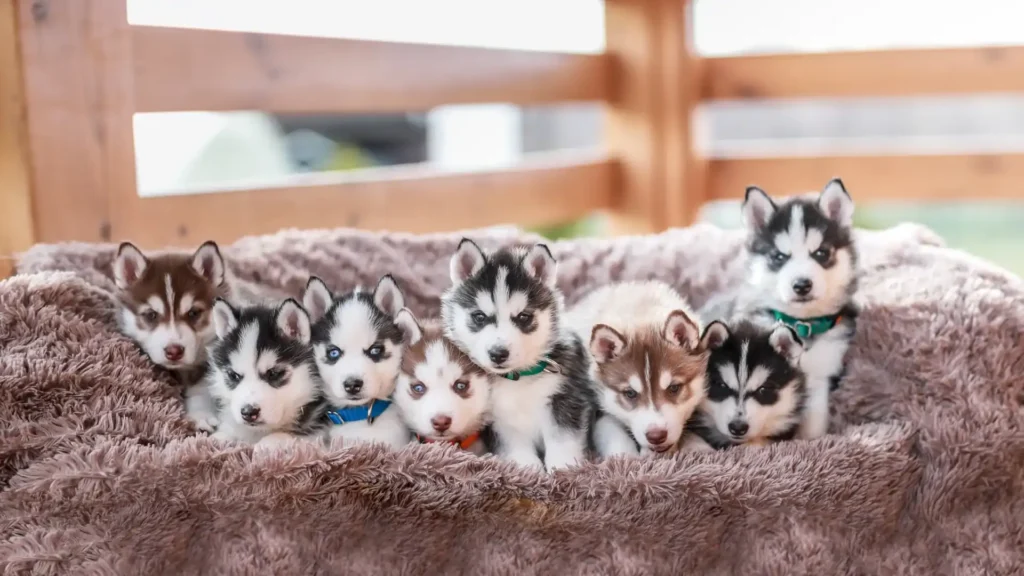When you think of a Husky, you will surely think of those eyes that are “full of murder” but with a little bit of “funny feeling”! Husky’s extremely “contrasting” appearance has made many people’s hearts melt with it, do you want to have a cute Husky too?

“Husky, also known as Siberian Husky, is commonly known as “Erha” (Er represents stupidity). In the earliest days, huskies came from the “Siberian sled dogs” and were used for “speed racing” because of their fast running speed, but nowadays, they are the silly babies in many people’s homes.
7 Qualities & Knowledge about Huskies
1. Appearance
The most special feature of a Husky’s appearance is its cool-looking but interesting eyes!
Most Huskies have blue or brown eyes, some are darker, some are lighter, and some may have blue and brown pupils.
Ears are raised upwards and are close together. The tail looks like a wolf’s, but usually hangs down naturally.
2. Fur color
Husky’s fur is “short and hard”, and the colors are mostly “black, white and grey”, but occasionally “reddish-bronze” or “brown”.
What’s special about them is that they have many kinds of patterns on their faces, some of which look like they are wearing “glasses” and others look like they are wearing “masks”, all of which are similar to wolves.
Because they live in cold areas, Huskies have two layers of heavy fur to keep them warm, and like cats, they undergo a “moulting” process in the spring and fall.
3. Physical Characteristics
Huskies are medium-sized dogs, with males ranging from 53 to 60 centimeters tall and females from 51 to 56 centimeters tall.
The body weight of male dogs ranges from 20 to 27 kilograms, while that of female dogs ranges from 16 to 23 kilograms.
4. Character Traits
The Husky’s personality is completely different from its cold appearance. It is very “affectionate” and “gentle”, and is even very friendly to strangers, which is why it is often said that the Husky is “incapable of being a watchdog”.
Huskies are not only friendly to people, but also to other animals, so if you want to find a companion for your pet, a Husky is a good choice!
5. Average life span
The average lifespan of a Husky is 12 to 14 years, which is considered a “long life” among many dog breeds.
Compared to other breeds, Huskies are relatively “healthy” dogs, with fewer inherited diseases.
However, they may still have diseases that other dogs may have, such as hip dysplasia and cataracts.
6. Always tearing up the house
I believe that even if you have never owned a Husky, you have heard that many Huskies have the skill of “tearing down the house”!
Why do Huskies tear down the house?
Because Huskies are firstly “working dogs”, they are “very energetic” and need “big power” every day. Since most people are “busy”, Huskies can only “tear down the house”!
7. Running super fast, and once saved 10,000 people’s lives
Huskies were first used as sled dogs in “speed races”, when people would select the fastest sled dogs and then mate them with each other.
In 1925, there was an outbreak of diphtheria in Alaska, and the serum could not be transported due to the lack of transportation.
The serum could not be transported due to the lack of transportation in the area, so the Huskies were able to deliver the serum in time by pulling a sled, saving the lives of 10,000 people in the area.
Are huskies suitable for newbies? Is it a good breed?

Is a Husky suitable for your first time pet owner? First of all, you need to know the personality of Huskies and their weaknesses!
About Husky’s Personality
Huskies are very “friendly” and “outgoing” and will love every member of the family, including children, other animals and even strangers, so they are very suitable as companion dogs.
Huskies are often laughed at as “clumsy”, but in fact they are more “individualistic” and “self-conscious” dogs!
When they recognize you as their leader, they will be obedient, so this may be a challenge for newbies!
Does the Husky have any defects or flaws? Are they prone to diseases?
Huskies are considered to be relatively “healthy and strong” dogs among the breeds, but there are still some “common dog diseases” that they may get.
1. Joint problems
Medium and large dogs such as Huskies, Labradors, and Golden Retrievers are prone to joint problems because of their heavy weight and the burden on their joints.
You can find out by observing your dog’s walking condition. If your dog walks shakily and is not very eager to go for a walk, you should pay attention to it.
2. Eye problems
“Glaucoma is a common eye problem in dogs, but Huskies are more prone to glaucoma than other dogs because of their genetic heritage.
Glaucoma in dogs is caused by elevated intraocular “pressure”, and when the dog gets older, the regulation of the eyes will become worse, causing the intraocular pressure to “increase” and pressurize the internal “nerve tissue” and “blood vessels”, which in turn leads to visual impairment.
In addition, common eye problems such as keratitis and cataracts may also be encountered by Huskies.
3. Endocrine problems
One of the most common problems in dogs is hypothyroidism, which usually occurs when the Husky is middle-aged.
Hypothyroidism can cause symptoms such as hair loss, lethargy, weight gain, constipation, mental retardation, and loss of coat luster.
4. Epilepsy
Epilepsy is a condition caused by “abnormal electrical discharges in the brain”. During epilepsy, a husky’s “muscles contract vigorously” and are easily injured.
There are many causes of epilepsy, and Huskies are more likely to have epilepsy because of their “genetic predisposition”.
5. Skin Problems
Huskies come from “cold” areas and are born with “thick fur”, and the weather in Taiwan can be a challenge for huskies.
Taiwan’s weather is “humid and hot”, so if you don’t pay attention to it, bacteria and viruses can easily develop.
6. Lots of hair loss
Huskies have a “double coat” that keeps them warm in cold areas, and this is why they change their coat every spring and fall.
Huskies have a large amount of hair and shed a lot of hair during the moulting period, so if you are allergy-prone or don’t have time to clean, you may want to consider this before keeping a Husky.
How much does it cost to keep a Husky per month?

In fact, the cost of keeping a Husky can be very high or very low, depending on the owner’s “keeping method” and the “needs” of the dog.
Basically, there will be medical expenses, food expenses, health care expenses, and daily necessities, and the average cost per month is about $3,000 to $5,000 or more, but some owners may spend more.
Before keeping them, you should understand the problems you may have to face in the future and decide whether to keep them depending on your own financial ability.
Generally speaking, “the first four months are more expensive”, and there are mainly one-off expenses such as microchip implantation fee, registration fee, and pet sterilization fee.
At the beginning, we need to pay for the dog’s daily necessities and set-up costs, followed by “food”, “medical expenses”, and “pet grooming expenses”.
Some situations may not happen as we expect, such as the cost of a doctor’s appointment for a sick Husky.
In Taiwan, dogs don’t have health insurance like we do, so the cost of treatment may range from $1,000 to over $10,000 dollars.
In addition to measuring their own ability, you can also refer to the current market for dogs to launch “pet medical insurance”, in the husky unexpected situation can come in handy, in case of emergency.
Does a Husky need a walk?

Huskies used to be “working dogs” for pulling sleds, so they are very energetic. It is recommended that you take your Husky out for a walk for at least one hour every day.
If the Husky is not able to go out for a walk to discharge the electricity, the situation of “tearing down the house” may be more serious!
When you take your Husky for a walk, it is recommended that you avoid hot weather and go out early in the morning or late in the evening to make sure that the floor has cooled down before you go out.
🐕Maintaining weight: Walking your Husky daily can help maintain weight and improve its muscle mass and heart health.
🐕Prevents Anxiety: On a mental level, it helps to prevent anxiety as Huskies can sense their external environment through “sniffing”, observation and interactive exploration.
🐕Socialization Skills: Walking provides Huskies and other dogs with opportunities to interact with people, which positively contributes to Huskies’ “socialization skills” and makes it easier for them to cope with different environments.
🐕Controlling energy: Huskies are usually very energetic, and a proper “energy release” can help them to be more calm in the home.
Husky Adoption Information
As with other dogs, you can refer to the following organizations for adopting a Husky:
🐕Animal Shelters: All counties and cities have animal shelters, which usually have dogs in need of adoption. You can find out if there are pets available for adoption at your local animal shelter and follow their adoption procedures.
🐕Animal Rescue Organizations: There are many animal rescue organizations that specialize in rescuing, caring for, and opening up for adoption dogs, including huskies, from the streets. These organizations often have “websites” or “social media” pages online that provide information about adoptable huskies.
🐕Online platforms: Online platforms such as Facebook groups, Instagram, websites (Taiwan Adoption Map, Global Animal Shelter Management System, etc.) often post information about huskies in need of adoption.
🐕Pet adoption events: Regular pet adoption events are often a great opportunity for you to interact with huskies and consider adoption. These events are often hosted by animal lovers and rescue organizations.
🐕Veterinary clinics: Some veterinary clinics may partner or offer adoption services, so ask your local veterinary clinic if they have any huskies available for adoption.
Whichever way you choose to adopt a Husky, as long as you follow the adoption process and take on the responsibility of caring for them, I believe you are ready to be a good owner!
